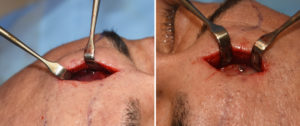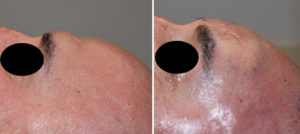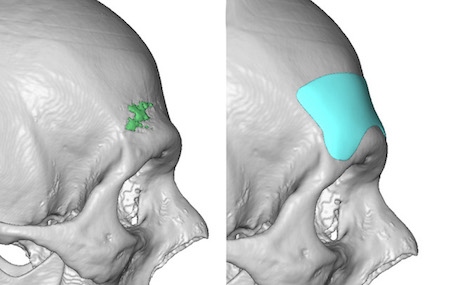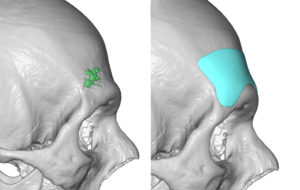Background: The overgrown or prominent brow bone in a male is most commonly treated by a brow bone reduction procedure, usually a setback bone flap technique. While this is a very effective operation, it almost always requires a superior or scalp incisional approach. For many men, particularly older men, this may not be a viable option considering their hair coverage. The male who shaves his head is the most significant example of when a brow bone reduction procedure can not be done. (unless it is done hrough a horizontal wrinkle line)
An alternative option in the shaved head male with prominent brow bones is to camouflage it by softening the transition between the brow bone and the forehead. This is known as the brow bone break area and it follows the superior protrusion line of the over expanded frontal sinus. By smoothing out this transition the brow bones appears to be less protrusive by comparison. The effectiveness of this brow bone camouflage procedure depends on the severity of the brow bone protrusion.In mild to moderate cases this may actually be preferred over setting the brow bone back. In more prominent brow bones profile computer imaging is needed to determine whether softening the brow bone break provides a noticeable aesthetic improvement.
The shaved head male, even if a brow bone break implant offers an aesthetic improvement, still needs to have a scar acceptable location for insertion. The use of horizontal forehead wrinkle lines and vertical glabellar furrows offers access through which a virtual scar already exists.
Case Study: This middle-aged male had prominent brow bones but was not a good candidate for brow bone reduction due to his shave head. It was determined that he was a good candidate for a brow bone break implant by prior injectable filler treatments and computer imaging. He also had a single deep vertical glabellar furrow which Botox and injectable filler injections could not solve.




Case Highlights:
1) In the male with an indistinct hairline or a shaved head, a traditional brow bone reduction is usually not an aesthetic treatment option.
2) Smoothing the transition between the brow bones and the forehead (brow bone break) could be a viable treatment option if the brow bone protrusion is not overly severe.
3) The placement of the custom brow bone break implant can be placed through an existing deep glabellar furrow in the older male.
Dr. Barry Eppley
Indianapolis, Indiana








